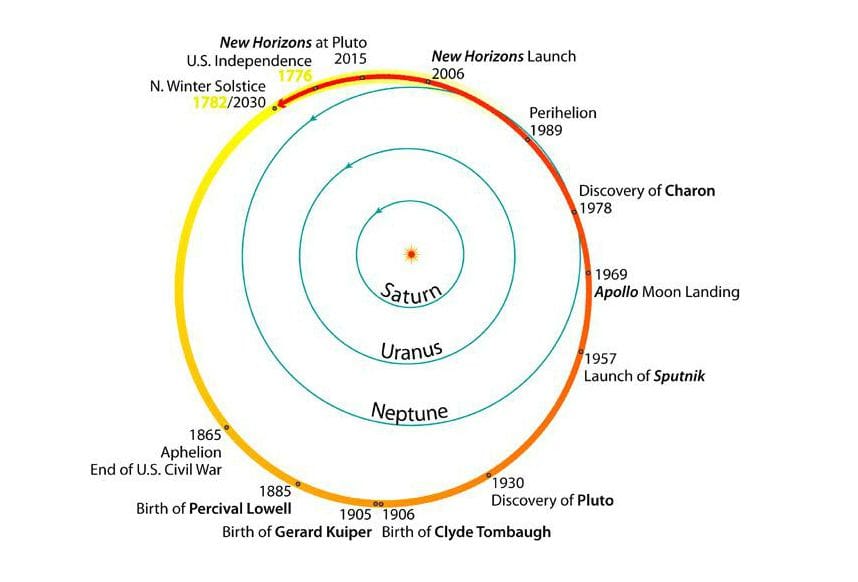Photo by NASA
Here’s a mind-bending fact to reset your perspective: the United States hasn’t even existed for one complete orbit of Pluto around the Sun.
Every moment of American history, from the first colonies to your morning coffee, has unfolded while this distant world made just a single lap around our star.
Pluto takes 248 Earth years to complete one orbit. The discovery of this icy dwarf planet in 1930 came at a point when America was already well established, and even today, Pluto hasn’t returned to where it was when Clyde Tombaugh first spotted it through his telescope.
The Orbital Timeline of Human Achievement
The visualization tells a fascinating story. When Pluto last passed its perihelion (closest approach to the Sun) in 1989, we were watching the Berlin Wall fall and using dial-up modems. But that same orbital position in 1741 predates the American Revolution by decades.
The outer arc of this cosmic clock captures the entire American experiment. The Civil War’s end in 1865, Sputnik’s launch in 1957, the Apollo moon landing in 1969, and the discovery of Pluto’s moon Charon in 1978 all happened along this same sweeping curve through space.
What This Means for Perspective
This isn’t just astronomical trivia. It’s a profound reminder of how young human civilization truly is on cosmic timescales. While we measure our lives in decades and our nations in centuries, the universe operates on scales that dwarf our grandest historical narratives.
Consider this: Percival Lowell, whose birth in 1855 is marked on this diagram, dedicated his life to studying Mars and predicting the existence of “Planet X” (which would become Pluto).
Gerard Kuiper, born in 1905, would go on to have the Kuiper Belt named after him, the region where Pluto actually resides. These astronomical pioneers lived entire lifetimes within fractions of Pluto’s journey.
Looking Forward and Back
New Horizons, humanity’s first spacecraft to visit Pluto, reached the dwarf planet in 2015 after a nine-year journey. By the time it arrived, Pluto had barely moved a few degrees along its orbital path compared to when the mission launched. The spacecraft is now heading into the Kuiper Belt, venturing into territory that will take it far beyond where any previous human-made object has traveled.
When Pluto completes its current orbit around 2178, what will Earth look like? What achievements will mark that outer arc? Perhaps interstellar missions or settlements beyond Mars. Or perhaps challenges we can’t yet imagine.
The next time you feel overwhelmed by the pace of change or the weight of history, remember: we’re all passengers on a small blue world, watching distant Pluto trace its patient circle through the cosmos. Our entire shared story so far is just one lap around an ancient track.
Help us out by sharing this map:
